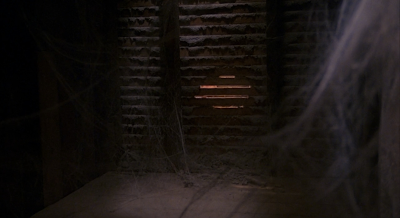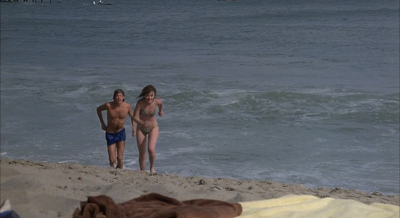Let us now visit the California coast in The Silent Scream (1979), an early slasher that arguably could be considered a proto-slasher due to the fact it began filming in 1977, before Halloween, though the finished version was rewritten and completed after Halloween's record-breaking box office success.
Some of your universe's critics do not appreciate the groundbreaking The Silent Scream. For example, reviewer donnyblvu writes, "I recommend this movie to your buddies whom you don't like. I mean that the person that you really want to waist [sic] 2 hrs of his/her time. This movie sucked so bad that I had nightmares..." Reviewer thesar-2 writes, "The movie's boring. Really. It contains odd characters as well as stereotypical (of 1980) characters, none of which are interesting." And reviewer Maciste-Brother writes, "SILENT SCREAM ain't much of a movie."
You must read on for the true story of The Silent Scream...
The film begins as policemen arrive in slow motion to a seaside mansion. Detective Avery Schreiber (words never before put together) and his partner Detective Cameron Mitchell burst through the front door and find three dead bodies in the attic.
The filmmakers cut to the bustling scene of college registration day in the late 1970s, a staff-intensive procedure where college students line up in various queues to speak with registration workers who arrange their physical examinations, course registration, and housing. A young woman named Scotty Parker is surprised to find no on-campus housing so she takes a referral sheet from the registration worker and drives her Datsun convertible to the same seaside mansion from the prologue. After some confusion about how many rooms are available to rent at the mansion, we are introduced to a slew of characters in addition to Scotty: Doris, a young woman; Peter, a Porsche-driving new tenant in the house; Jack, the current tenant in the house; and Mason, a teenage boy who lives in the house who ominously tells Scotty she is taking his sister’s room.
As soon as Scotty lies down on the bed in her new room, the filmmakers zoom in on a ventilation grate — to reveal a person staring at her from behind the grate!
In an effort to find a place for her suitcases, Scotty ventures to the attic, being careful not to both the landlady, Mrs. Engels (played efficiently by Yvonne De Carlo), whose bedroom is next door to the attic. Scotty, however, does both Mrs. Engels, who stares at her wordlessly while the soundtrack crescendoes to generate chilling suspense. Then Scotty goes back to her room, suspicious of the middle-aged woman.
The college students, including their other roommate Jack, decide to walk down the beach to a restaurant so Peter, the Porsche-driver who bragged about his income, can pay for dinner. As they walk away from the house, director Denny Harris’s camera creeps back toward the house, dissolving to the basement windows and then into the basement and behind a wall, where we see the shadowy staircase and hallways occupied by the mysterious person behind the ventilation duct. We hear scratching and see that the person is scraping away some mortar to break into the secret tunnels behind the walls…
(As with the scene with Mrs. Engels, the music crescendoes when a hand breaks through a slat, though the action is not surprising or particularly thrilling.)
At the beachside restaurant, the four college students drink bear and then take a drunken walk on the beach. Scotty and Jack reach the house before Doris and Peter. When Jack kisses Scotty at her bedroom door, Mason watches them from his own room.
Back at the beach, Doris and Peter are trapped by the rising tide. Doris crosses the rushing water first, and then is surprised when Peter disappears. The soundtrack again crescendoes, but we soon learn Peter has somehow played a practical joke on Doris, passing her in the waves. When he comments on her breasts, Doris slaps Peter and leaves him on the beach. After she is gone, Peter sees someone and says, “Hi. How you doing?” — but he is stabbed in the chest for his concern.
Later, Peter’s bloody body is found buried in the sand, and he is taken to the local police for an autopsy.
Finally giving the audience what it wants, the filmmakers present a scene featuring detectives Avery Schreiber and Cameron Mitchell, the most exciting buddy cops of the late 1970s. Detective Schreiber, wearing his best red llama necktie, goes to the boarding house to ask questions of the college students.
Meanwhile, Detective Mitchell interviews Mason, who explains that he and his mother live in the house, and that his father is dead and his sister Victoria went away (“She’s back east”). Mason then goes to his room, opens an Army trunk at the foot of his bed, and looks at his late father’s military uniform and medals. “What about me, Father?” Mason whispers despairingly. “What does she think this is doing to me?”
After school, Scotty and Jack go swimming at the same beach where Peter was murdered — an activity that takes some convincing, as Scotty is leery of going back to the beach. Jack perseveres, however, and they swim for a few minutes in the cold water.
The swimming at the murder beach leads, as such activities inevitably do, to drinking Olympia beer and having sex at the creepy boarding house to the strains of saxophone music.
Unfortunately for Doris, who is downstairs in the laundry room/basement and who hears her friends having sex through the air ducts, someone enters the basement and stabs poor Doris to death. In her death throes, she grabs a sheet hanging from a clothesline and pulls it down in a clever reference to the shower curtain’s final fate in Psycho (1960).
Back at the police station, Detective Cameron Mitchell tells his captain that the investigation is centering on the boarding house and its occupants. Detectives Mitchell and Schreiber (who, unfortunately, does not eat Doritos in this film at all, despite appearing in many Doritos TV commercials since at least 1975) come across some backstory: Mason’s sister Victoria attacked someone with a knife in the 1960s after being jilted by a boyfriend. They decide to track Victoria down.
Back at the house, director Denny Harris again makes effective use of his prowling camera as it moves past Mrs. Engels sleeping in a rocking chair to dissolve through a door and find a hidden room where a Barbara Steeler sits in front of an old black and white portrait.
The camera also reveals that Doris’s dead body is sitting in the room. Barbara Steele, playing Victoria, has pleasantly made up Doris’s face and put a flower garland in her hair.
After sending Jack to his room, Scotty climbs the stairs down to the basement looking for Doris. Instead, she discovers a panel behind the laundry. Taking a flashlight, she investigates and finds the secret staircase behind the walls. (It is unclear why she does this, especially as she is wearing only a thin bathrobe.) After she climbs through hidden tunnels for a while, Scotty is grabbed by Victoria and pulled through an open panel. Her struggles are heard by Mrs. Engels, who wakes up and rescues Scotty from Victoria.
Meanwhile, Jack sees that Scotty’s room is empty, so he puts on a shirt (failing to button it, oddly) and explores the house. He tries to get into the hidden room, where Mrs. Engels holds her hand over Scotty’s mouth while Mason and Victoria look on, but he fails. Then, as Jack is the only in-murdered, in-abducted college student left, the film follows him as he walks through the house for five minutes or so.
Back in the hidden room, Mason and Mrs. Engels argue about the backstory, explaining that they shouldn’t have started renting out rooms in the house because someone might discover Victoria. Mason cries, “What about me? The only thing you’ve ever thought about is Victoria! Can’t you see how you’ve let her ruin my life?”
“You don’t know what you’re talking about,” his mother explains. “You’re the one. You’re the one who has ruined her life.”
“Mother, how can you say that to me?”
“Don’t you understand? Haven’t you ever guessed the truth about Victoria? And about yourself?”
A musical sting accompanies a flashback to an earlier time, when a pregnant Victoria horrifically hangs herself in a room in the boarding house.
Victoria survives when the rope breaks, but she is catatonic and institutionalized. The film reveals that, shockingly, Mason is actually Victoria’s child!
Finally finding out the truth, Mason runs out of the room and locks himself in his own bedroom. Jack soon finds Mason, but Mason knocks him out by hitting him with a desk lamp. Then Mason opens his “father’s” (actually his grandfather’s) Army chest, where he pulls out a service pistol.
With all this excitement going on, the filmmakers can do nothing but cut back to the police station, where Detective Cameron Mitchell fills out paperwork. Detective Schreiber enters his office and explains even more of the backstory: Victoria was institutionalized and had a lobotomy, but Mrs. Engels took her out of the institution. The detectives decide to rush to the mansion in the dead of night.
Mason, revealing himself to be the most unhinged member of the family, dresses in his grandfather’s uniform and threatens to shoot Scotty. In a clever inversion of Norman Bates, Mason believes himself to be his own father/grandfather, and he must fix everything to protect his family.
Mrs. Engels attacks Mason and the gun goes off eight times. Mrs. Engels is shot. Mason stands over her body, and Victoria grabs a knife and slowly, threateningly approaches Scotty, whose hands are tied to a curtain rod.
Victoria turns her attention to Mason, however, and Mason shoots her. Then, instead of shooting Scotty, he decides to shoot himself.
In a slasher movie staple, as Scotty frees herself, Victoria jumps back up and threatens Scotty with the knife. Fortunately, Scotty manages to close the door on her, saving herself. Scotty pushes Victoria onto her own knife.
The detectives arrive and find Mrs. Engels, Mason, and Victoria dead.
The film simply ends, with no explanation about whether the police believe Scotty and/or Jack, as the only survivors, to be responsible for murder.
The Silent Scream accomplishes a remarkable feat: It casts Barbara Steele, Yvonne De Carlo, Cameron Mitchell, and Avery Schreiber in important parts, but the script cleverly focuses only on the young, unknown actors, giving only scant screen time to the Hollywood legends. Director Denny Harris tones down the material for the older, experienced, good actors, presumably in order to direct the audience's interest toward the younger, inexperienced, less good actors so that the viewer is unable to suss out which characters are important and which are not.
Written (or re-written) by Jim and Ken Wheat, the talented screenwriters responsible for such films as The Fly II (1989), After Midnight (1989), The Birds II: Land's End (1994), and Pitch Black (2000), the script for The Silent Scream is notably straightforward, presenting a group of people, forcing them into close quarters, and killing a few of them off. Most whodunnit slashers are needlessly complicated as they introduce red herrings, but The Silent Scream solves much of this complexity by having its murderer hide in the walls, an unknown character to most of the cast who are barely aware they are in a whodunnit. Given the efficient execution of the film and its box office success as part of the slasher golden age, it is something of a tragedy that director Denny Harris did not make any other movies. A sequel or prequel would have been a surefire hit, as would a series of detective movies starring the charismatic team of Avery Schreiber and Cameron Mitchell. Who wouldn't want to see this odd couple solving slasher mysteries year after year? Nobody, that's who.












